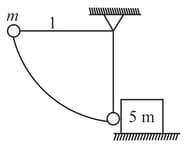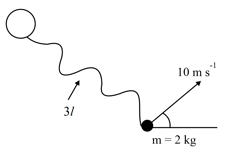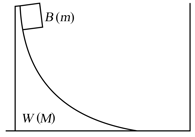Velocity of a particle of mass changes from to after colliding with
a plane surface.

Important Questions on Impulse and Collision

A ball of mass is dropped from a height of on smooth inclined plane. The coefficient of restitution for the collision is The ball's velocity become horizontal after the collision.
A pendulum bob of mass connected to the end of an ideal string of length is released from rest from horizontal position as shown in figure. At the lowest point, the bob makes an elastic collision with a stationary block of mass which is kept on a frictionless surface. Mark out the correct statement(s) for the instant just after the impact.

A string of length is connected to a fixed cylinder whose top view is shown in the figure. The string is initially slack. The other end of the string (connected to a marble) is moving at a constant velocity of as shown. The string will get stretched at some instant and impulsive tension occurs in the string. If hinge is exerting a force of for on the cylinder to bear up the impact of impulsive tension, then mark the correct statements. (Take string to be light, breaking tension of the string is )

In the figure, the block of mass starts from rest at the top of a wedge of mass All surfaces are without friction. can slide on the ground. slides down onto the ground, moves along it with a speed has an elastic collision with the wall, and climbs back on to

Two blocks and of masses and respectively placed on a smooth floor are connected by a spring. A third body of mass moves with velocity along the line joining and and collides elastically with At a certain instant of time after collision it is found that the instantaneous velocities of and are same then

The wall is at extreme right is fixed as shown in figure. Coefficient of restitution for collision between two balls is and between ball and wall is Then speed of A and B after all possible collisions are

